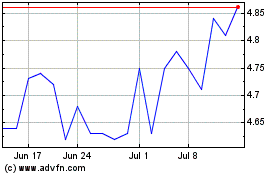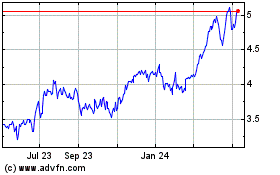By Ryan Tracy and Donna Borak
Big U.S. banks won permission from regulators Wednesday to boost
dividends and buybacks, offering investors some welcome news after
the sector got hammered when the U.K. voted last week to exit the
European Union.
All but two of 33 institutions passed the final round of the
Federal Reserve's annual "stress tests," conducted to gauge how
such firms would fare in a new financial crisis.
Big firms such as Bank of America Corp. and Citigroup Inc.,
which struggled on the tests in recent years, passed this time.
Morgan Stanley also passed but received a bit of a rebuke. The Fed
said it found "weaknesses" in internal risk- management processes
and required the bank to submit a revised capital plan by the end
of the year, though it will still be able to return capital in the
meantime.
Morgan Stanley Chairman and Chief Executive James Gorman said
that the firm is able to increase its capital return to
shareholders for the fourth consecutive year, adding "we are
committed to addressing the Fed's concerns about our capital
planning process and fully expect to meet their requirements within
the established time frame."
The U.S. banking units of two foreign firms, Deutsche Bank AG
and Banco Santander SA, were flunked, due to Fed concerns about
their ability to measure risks. It was the second year in a row the
German bank failed and the third consecutive failure for the
Spanish firm.
Overall, the 2016 stress tests reflect the Fed's view that the
banking sector is much stronger than it was leading up to the 2008
bailouts. Bank regulators have steadily raised capital requirements
for the largest banks since the crisis to make banks -- and the
financial system -- more resilient and better able to absorb
losses. The changes have forced banks to fund themselves with less
borrowed money and more investor funds, such as common equity that
can't flee when market turmoil strikes, and many analysts said
those changes helped contain the damage from the Brexit market
rout.
The stress-test result could prove a tonic for bank stocks,
which have been wilting of late. Falls in long-term bond yields
earlier this month promised to further pressure profits, and
additional declines following the Brexit vote made the outlook
worse. Fears of a hit to global growth after the U.K. vote, along
with the prospect of market turmoil, cast an even darker cloud over
banks.
Despite the firming of stocks generally in the past two days,
the KBW Nasdaq Bank Index remains down 7% from its level when the
Brexit vote was announced. Among S&P 500 sectors, financials
are the worst performer this year, down 5.6%. The stress-test
results were announced after U.S. markets closed, and Bank of
America, Citigroup and J.P. Morgan Chase & Co. all followed the
Fed report by announcing they would boost capital returns to
shareholders. In after-hours trading, shares of Citigroup were up
around 2.3%, Bank of America 1.7% and J.P. Morgan 1.4%. Despite its
conditional approval on the test, shares in Morgan Stanley rose
1.2%.
This is the second set of stress-test results released by the
Fed over the past week, assessing whether officials believe the
biggest banks could continue to lend even during a deep recession.
Last week, the largest U.S. banks breezed through the first round
of tests with capital ratios well in excess of the amount the
regulator views as a minimum, even when put through a hypothetical
recession.
Born of the financial meltdown in 2009, the stress tests have
become a defining moment each year for big banks and investors.
Bank executives manage their firms with one eye on how it will
affect test results and have had to spend billions of dollars to
develop systems to deal with them. They have become crucial for
investors ever since the Fed decided in 2011 that the banks would
have to submit capital-return plans as part of the tests and
dividends and buybacks became dependent on the outcome of these
hypothetical exercises. Some bankers have criticized the Fed's
process as overly opaque and stringent and have complained that the
higher capital required by them has choked lending and harmed the
economy. That said, both bank executives and regulators have said
the tests have made banks stronger and forced improvements in the
ways that banks measure and manage risks.
Banks that received approval for their capital plans will be
able to pay out as much as around two-thirds of projected net
income for the coming four quarters, a senior Fed official said.
That also means, though, that banks will continue to retain
capital, which could also reassure investors worried about their
ability to withstand any continuing Brexit-related market
tumult.
Nevertheless, a document issued by the Fed Wednesday outlined
areas where the regulator expects further improvement next year, a
reminder that future stress-test successes aren't guaranteed.
For Deutsche Bank and Santander, the Fed's rejection of those
firms' capital plans is a public embarrassment, but the practical
impact is more limited. The rejection effectively locks up some
U.S. profits, which can't be sent home to the parent firms at a
higher rate until they pass the tests, but the firms don't have
publicly announced plans to return capital home that would be
affected by that restriction, a Fed official said.
The official, on a conference call with reporters, didn't say
the firms would face harsher sanctions in the future and suggested
both firms are making progress. They have dedicated substantial
resources and manpower to addressing regulators' concerns, but the
Fed still believes the firms have substantial work to do, for
example, by ensuring they have reliable data about all of the risks
they face, the official said.
"We appreciate the Federal Reserve's recognition of our
progress, and we will implement the lessons learned this year in
order to strengthen our capital planning process," said Bill
Woodley, deputy CEO of Deutsche Bank Americas.
In a statement, Santander Holdings Chief Executive Officer Scott
Powell noted that the company has strong capital levels and would
work to address regulators' other concerns. "We have made progress,
but our internal capital planning, stress testing, internal
controls, governance and oversight require further improvement to
meet our regulators' expectations," Mr. Powell said. "We are
financially sound. These results do not affect our ability to serve
our customers," he added.
Santander executives have said during the past couple of years
that the regulatory troubles in the U.S. are partially the result
of growing pains as the lender builds up a holding company to
oversee its banking unit and consumer-lending subsidiary.
But U.S. regulators have also faulted Santander for
risk-management problems broadly, and investors and analysts say
they are growing impatient with Santander's mess in the U.S.
The Deutsche Bank unit in question, Deutsche Bank Trust Corp.,
represents about 3% of the German lender's total global assets. A
bigger test for Deutsche Bank will come in two years when its
bigger, newly consolidated U.S. business -- set up as what is known
as an intermediate holding company -- comes fully under stress-test
review.
Two new entrants to this year's test -- BancWest Corp., a
subsidiary of France's BNP Paribas SA, and TD Group U.S. Holdings
LLC, which is owned by Toronto-Dominion Bank -- passed the Fed's
yearly exercise.
M&T Bank Corp. gained the Fed's approval, but the Buffalo,
N.Y., firm passed only after scaling back its proposal to
distribute funds to shareholders, to ensure its capital buffers
stayed above the minimums required by the Fed.
It was the only bank to take the "mulligan" allowing banks to
adjust their payout plans. Had the bank not done so, it would have
failed the test by falling below two of the four required capital
ratios in a hypothetical recession, the Fed said.
The Fed changes the details of its recession scenario from year
to year, so the specifics can hit one type of bank harder than
another. This year, the Fed's hypothetical scenario envisioned the
U.S. unemployment rate more than doubling to 10%, the stock market
losing half of its value and financial markets becoming so
topsy-turvy that short-term U.S. Treasury rates turn negative as
investors pay the U.S. government to hold their money.
--Christina Rexrode, Jenny Strasburg and Jeannette Neumann
contributed to this article.
Write to Ryan Tracy at ryan.tracy@wsj.com and Donna Borak at
donna.borak@wsj.com
(END) Dow Jones Newswires
June 29, 2016 19:37 ET (23:37 GMT)
Copyright (c) 2016 Dow Jones & Company, Inc.
Banco Santander (NYSE:SAN)
Historical Stock Chart
From Mar 2024 to Apr 2024

Banco Santander (NYSE:SAN)
Historical Stock Chart
From Apr 2023 to Apr 2024
